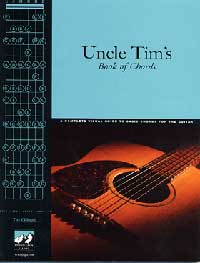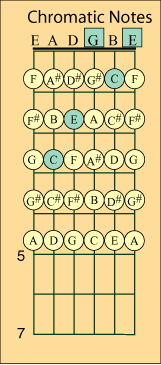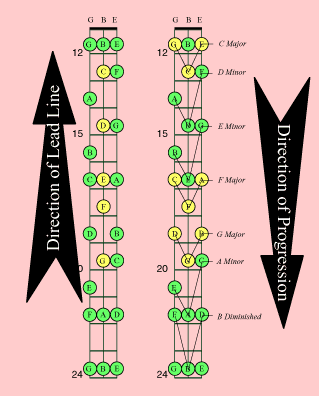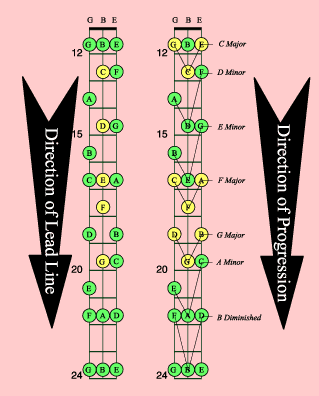

Keys Are The Sure Way To Build Songs!
Keys seem to be the hidden ingredient to playing a guitar. Once you know keys you can immediately start playing the chords in the key and constructing songs based on the chords in the key.
Triads are the simplest chords you can create and they flow up and down the fretboard providing easy access to any chord in any key with hardly any effort.
And when you are constructing a song, there is no better tool available anywhere. And the knowledge you get will set you free!
There is nothing like it and nothing that can make composing songs as easy as this. For $20, you can have a resource that will always show you all the choices for where you are working. Pick up a copy today.
eBooks are delivered instantly!
Once a person begins to want more complex sounds from their playing, the search for additional notes and complex melody lines is on. Sooner or later everyone wants to hear more complex sounds and greater ability to show up. Playing simple chords just won't cut it anymore. When this happens, it opens a whole new world of sounds and places greater demands on both hands. If a guitarist can find some avenues of growth, everything can fall right into place, with a little work of course.
This can be a great opportunity to apply more advanced techniques and turn them into advanced skills. If you have been finger picking and playing scales, now these tools can be applied to bring your playing to a whole new level. These changes are subtle. Anyone listening will soon figure out that these more complex sounds are not coming from a beginner. These are signs of maturing as a guitarist. So let's take a look at some notions of theory that you can apply to your playing and jack things up a bit.
When new guitarists start to compose new songs, they usually use some pretty plain chord progressions and almost never pepper them with single note passages. This is a symptom of embracing the possibilities for construction but not being far enough along to develop intricate compositions. After a while a new guitarist will notice someone else combining chords with accent notes and running single note lines in between chordings to add additional interesting components to a song.
When this type of approach is used, the music becomes much fuller and adds sophisticated structures that make it much more intricate and interesting. It usually becomes more interesting because there are additional elements for your ear to follow and decipher. When only a single melody line is used, it can become mundane and the listener may get bored with the piece. This is not always the case but often times it is.
When a guitarist puts in enough time to develop their skills, they usually expand on their current level of skills and this can lead to more complex fingerings, progressions and songs. The more you can do, the more interest you can generate. For myself, I found I would get bored with simple progressions and for my own entertainment I began to add more notes in a fashion that would give my ear something to follow.
The notes that I began to add were usually based on some line that would work with or against the chording I was playing. This first showed up in finger picking with accent notes. As I grew to seek out these additional notes, my mind began to want to link them together and create more complex lines. Usually they would follow the basic diatonic structure of the song. I would just add notes in the scale and stitch them into the basic progression of the piece I was playing. Later when I learned how to play leads over recorded music or another part being played by another musician, my approach opened up and grew in complexity. Eventually I began to add passing notes and develop contrary lines of motion. I never studied this at first, but rather I stumbled on them and found the sound to be quite pleasing. It was only after I had developed a liking for this type of approach that I came across documentation explaining what I was doing.
I have never been one to adhere to strict formulas for how to use some component of music. Usually I would just keep experimenting until I found some elements that sounded good together or added the sound I was after. I am not alone in this type of approach, many, many guitarists just do what they want and don't stop until they are satisfied with the sound. I think this is the best approach because the rules of music should not stop anyone from experimenting with the combinations they find most pleasing. But rather all of the notes, chords and issues of timing should be at your disposal without anything being considered "out of bounds". If it sounds bad or unappealing, that should be the guidelines of inclusion or exclusion. Not some arbitrary rules that tell you what you can and cannot do. I would keep that in mind when we move on in this discussion because if you look at historical rules and guidelines they have a tendency to dictate what you should do.
A good example is the Melodic minor rule that states you should sharp the 6th and 7th degree of the natural minor scale when ascending and return to the natural minor fingerings when descending. Although this is based on a practical approach of years gone by, there are instances in modern music where violating this rule is acceptable. It may impinge on the melodic quality of the scale or lead line but you should do what sounds most appealing to you.
Much of this is based on what actually sounds good at the time. Over the years, decades and centuries, the notion of what sounds good changes and so the rules may not reflect this. Rules that made sense 100 years ago, may not apply to modern music. After all no one played an electric guitar back then.
So with that lets go look at some concepts that can add excitement to your music.
Accent Notes

 Accent
notes can be any note available on a guitar, regardless of the key you
are in or any rules that apply to music. If you are adhering to the
rules of Diatonic keys and the available notes are not getting it done
for you, then start violating them and see if that helps.
Accent
notes can be any note available on a guitar, regardless of the key you
are in or any rules that apply to music. If you are adhering to the
rules of Diatonic keys and the available notes are not getting it done
for you, then start violating them and see if that helps.
Signatures are great for understanding all the choices for note selection in a Diatonic sequence, but sometimes the best note may not be in the diatonic sequence. I have seen songs go along totally inside the boundaries of a Diatonic key and then abruptly add a note outside of the diatonic sequence. At times this can be the exact right note for the application. Sometimes it is hard to figure out why it adds such a nice sound, but nevertheless it does. So what is to stop you from using it. Certainly not an arbitrary rule.
In these examples to the right, the C chord is shown along with neighboring notes. My first choice is to use the Diatonic notes, however, at times the Chromatic scale yields choices that are more favorable.
I like these partial signatures because they show all the options close at hand. What you do with it is your business. There are several general options and lines of thought and that is what we will consider next.
Contrary Lines Of Motion
As the name implies, a contrary line of motion is usually a single note line that moves in a direction opposite to the underlying progression of chords. However it is not limited to just single note lines. So if you are playing a progression like C major, F major and them G major, the single note line may move backwards like this, G, F, E, D and then C.
As the chording is moving up the scale, the single note line is moving down the scale. In this way two distinct lines of motion are created. The chord progression is creating an upward motion while the single note line is creating motion that travels down the scale. If you try to do this, you may find that your first few attempts leave something to be desired. You can follow these rules and come up with mishmash. Or you may find a tasteful statement that plays off the chording. If you have been playing scales for a while and have advanced with your chording you may be able to add these elements without missing a step and at the same time add very interesting components to your music. In fact the effect may be so strong that the initial feeling you get when listening to the chords, disappears altogether and is replaced by entirely new feelings.
 Here is an illustration
of what I just described. Notice the chords on the right side are moving
downwards (top to bottom).The first chord is a C major, then the F major
and finally the G major. The left hand side contains single notes that
proceed from G to C and the direction of notes is opposite of the chording.
This is a typical example of contrary motion. Keep in mind that this
is a simple example and not all examples will be so straightforward.
The chording may move back and fourth and not be perfectly upward as
in this example. The same goes for the melody line. It may wander up
and down but the overall feeling of the lead may be in one direction
or the other.
Here is an illustration
of what I just described. Notice the chords on the right side are moving
downwards (top to bottom).The first chord is a C major, then the F major
and finally the G major. The left hand side contains single notes that
proceed from G to C and the direction of notes is opposite of the chording.
This is a typical example of contrary motion. Keep in mind that this
is a simple example and not all examples will be so straightforward.
The chording may move back and fourth and not be perfectly upward as
in this example. The same goes for the melody line. It may wander up
and down but the overall feeling of the lead may be in one direction
or the other.
Also this is not limited to a line of chords and a single note line. It can happen with two lines of single notes or two lines of chords. So the concept describes two lines of any type. They can be whatever you choose them to be.
But for now this simple example shows the overall principle in action.
Contrary motion describes this process nicely. After all the motion of the two lines is contrary to each other. But this only describes this type of motion. As you can imagine, you can easily have a situation where both lines travel in the same direction. In that case it is called Similar motion. That example is next.
Similar Lines Of Motion
 In this example
the lines are traveling in the same direction. Both lines are traveling
upwards. They both create a direction that provides a feeling the piece
is moving upwards.
In this example
the lines are traveling in the same direction. Both lines are traveling
upwards. They both create a direction that provides a feeling the piece
is moving upwards.
That describes motion when the two obvious directions are concerned. But there is also one more example.
Oblique Motion
In this case one of the lines stays in the same place and the other line moves either upwards or downwards. The trick to this is determining how a line stays in the same place. Open string chords may provide this sense of staying in the same place. Or maybe it is achieved by a progression that does not provide a sense of climbing or falling. Or maybe it involves only one chord that is played with no other support. But it also can be explained with more elaborate progressions. In these examples the chording is quite simple and expressed only as three chords. In reality the progression may be much more elaborate and include many more chords. So the direction established by the chord line may indeed create a very intense feeling of movement. Then when you compare a static line that offers no sense of movement, you can more easily determine that the line stays put without imparting a sense of movement.
Contrary motion refers to the direction of motion only . It does not specify what notes are appropriate. In these examples we have stayed inside the key and used the notes inside the scale. However there is a related concept that should also be explored in conjunction with contrary motion. That is the idea of passing notes.
Passing Notes
In the examples above, the examples were strictly diatonic. I mean that all the notes came out of the same scale regardless of weather or not they were chords or single note lines. However with passing notes that is not the case.
Passing notes are notes that pass by tones or chords but are notes not contained in the key. Here is the example with passing notes used (orange notes). These notes are not in the scale. Everything else in this illustration is in the key of C major which means only the notes of C, D, E, F, G, A and B are used. You can see that the notes in orange are C#, D#, F# G# and A#.
But there is more to passing notes than just using notes outside of the key. Usually these notes are used when passing between two chords. For instance if you were traveling between F major and G major you might pick up and F# note as in the example to the right. So the note is used in passing from one chord to the next. So in this example we are moving from F major to G major and in passing we pick up an F# note. That means that on that string we played the F note, the F# note and then the G note.
However that is only one way of using passing notes and I would not limit this trick to just this example. In Jazz or Blues scales, an additional note is used to create the Blues note which could also be considered a passing note. Technically it is not a passing note because in the Blues scale, this note might be the blues note that is part of the scale. Passing notes are usually outside the scale and key. This is challenged when opening this approach to scale groups more complex than the diatonic keys in which these additional notes are actually part of the scale. This is what I mean when I say be careful about strict interpretations of the rules. Let the music decide what sounds good, and then do that.
Recap. Passing Notes in the key of C.
You can think of passing notes as any notes not found in the scale. The key of C has five possible passing notes. There are twelve total notes, seven of which are in the key of C. This leaves five possible notes to serve as passing notes for this key. This formula will apply for every diatonic key.
Passing notes can be real trouble to manage if you do not take care how and where you insert them. You can think of them as the anti-tonal notes. Stick one in the wrong place and you will quickly find out that some of them do not mix well with pure diatonic structures. Diatonic keys are not arbitrary collections of notes. All the notes belong together and because of the unique construction of the keys, they all relate to one unifying note, the keynote. This forms a very strong set of relationships which are violated by notes outside of the key. This violation is the province of the passing notes.
Passing notes are very useful tools for changing the sound of music. They can be used as a fluid mechanism to transition to nearby chords or opposing chordal structures. They can also be used to upset the natural flow of a diatonic sequence.
Contrary Motion
The uses of passing notes is varied in nature and intensity. They can be used sparingly or as the central hook of a composition. Passing notes can also suggest motion. Chordings can provide the basic sense of movement as you construct a progression. Passing notes can be used to forge a new direction to the piece by climbing or falling and influencing the feel of the chord progression. This secondary line can either climb with the chords or fall with them, this is referred to as similar motion. When a chord progression climbs and the secondary line falls, contrary motion is established. The reverse motion also sets up contrary motion.
Oblique motion happens when one part stays on a note, chord or feeling and the second part either climbs or falls. When the parts proceed using the same intervals, it is called parallel motion.
Conjunct motion and disjunct motion refers to individual
parts. When you move to an adjacent note you have conjunct motion. Disjunct
motion results when you choose any other note to move to other than
the ones right next to it.